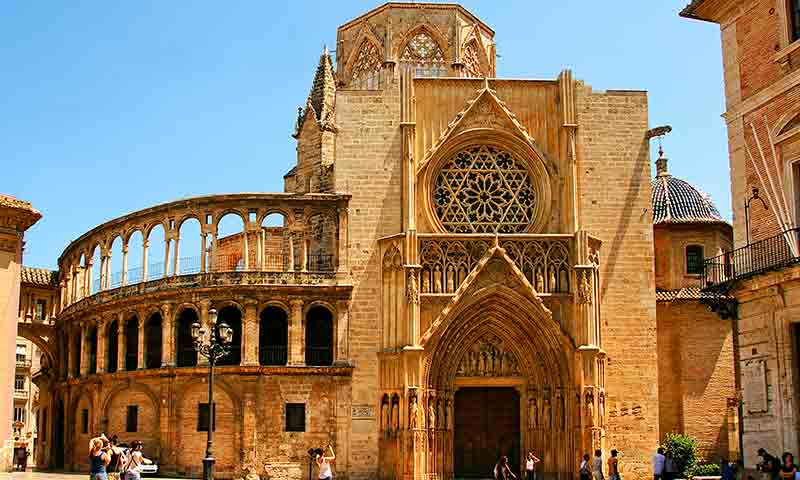Hay quien asegura que los arroces valencianos son como tener “el universo en un plato” debido a su variedad de sabores y presentaciones.
Esto se debe a que el cultivo del arroz ha sido muy importante en la Comunidad Valenciana, lo que ha influenciado su gastronomía, convirtiéndose en uno de los protagonistas de algunos de nuestros platos más populares. Por eso, tampoco es casualidad que el “arroz a la valenciana” forme parte de diferentes gastronomías, incluyendo la argentina, la colombiana, la cubana, la uruguaya o la filipina.

Las recetas de “arroz a la valenciana” se repiten en todo el mundo, aunque con diferentes notables.
Por ejemplo, el arroz a la valenciana de Bolivia es una preparación muy popular que lleva pollo y verduras, mientras que el de Chile se prepara con una selección variada de mariscos.
En todos los casos, el arroz se deja seco y lleva azafrán para imprimir su característico color.
Sin embargo, si estás en España, no oirás hablar del arroz a la valenciana, sino de la “paella valenciana”, posiblemente nuestro plato más internacional y que también admite muchas variantes.
La receta “tradicional” se elabora con arroz, pollo, conejo, judía verde plana, garrofó, agua, aceite de oliva y azafrán, pero, en la Albufera, es muy típica la paella de pato.
En las zonas del interior de la región, suelen añadirse pilotes (bolitas de carne) o costillas de cerdo, además de verduras como la alcachofa, y en la provincia de Alicante es habitual que la paella lleve pimiento o ñora.
Arroces más allá de la paella

Además de la paella, si vienes a Valencia podrás degustar ricos arroces de carne, pescado o verduras.
Estos son algunos de ellos:
Arroz de bogavante

El arroz con bogavante es uno de los arroces más populares del litoral español. Lleva bogavante, gambas y gambones, y normalmente se sirve “caldoso”.
Arroz negro

Otro de los arroces de pescado más conocidos es el arroz negro, que debe su color a que, en su elaboración, se emplea tinta de sepia o de calamar. Se sirve siempre seco (sin caldo) y para su preparación es indispensable hacer un buen sofrito, un buen caldo de pescado y una selección de moluscos y mariscos.
Arroz “a banda”

El arroz a banda es muy popular en toda la Comunidad Valenciana. Se trata de un plato “marinero” para el que se utilizaba “la morralla”, es decir, aquellos pescados que por la cantidad de espinas o por su aspecto eran difíciles de vender en las lonjas.
La principal curiosidad de este arroz es que no es un plato, sino dos: por una parte, se sirve el caldo de pescado con patatas y, por otro, el arroz seco y acompañado de alioli.
Arroz con costra

El arroz con costra es típico de la provincia de Alicante. Se elabora con todo tipo de carnes (conejo y cerdo, fundamentalmente) y se prepara en cazuela de barro y al horno. Justo antes de terminar la cocción del arroz, la superficie se baña con un huevo batido. El resultado es un guiso con una capa superficial dorada y que le da un sabor único.
Arroz al horno

El arroz al horno es uno de los mejores ejemplos de la cocina de aprovechamiento. Para prepararlo, se utilizan los restos del cocido (junto con el arroz, en este plato encontrarás garbanzos, morcilla o la peculiar pelota de carne, además de tomate y ajos). Normalmente, se sirve en cazuela de barro. Por eso, en algunos pueblos se conoce con el nombre de “cassola”.
Arroz “del senyoret”

Este arroz seco tiene la peculiaridad de que todos sus ingredientes están pelados, de manera que, al comerlo, no tenemos que pelar ni los pescados ni el marisco y no tenemos que mancharnos las manos. Originario de Alicante, en algunos restaurantes se conoce como “arroz ciego” porque puede comerse con los ojos cerrados.
Arròs amb fésols i naps

El “arròs amb fesols i naps” es típico de las comarcas de La Safor, La Marina Alta y Baja, La Ribera o l´Horta. Suele cocinarse en grandes recipientes, y es popular en comidas con muchos comensales. Sus principales ingredientes son judías blancas, nabos, carne de vacuno, carne de cordero, carne de cerdo y carne de conejo.
Si quieres probar uno de estos deliciosos arroces, te aconsejamos que vengas a Valencia y te recomendaremos los mejores sitios.
También puedes aprender español en nuestros cursos intensivos y conocer gente de todo el mundo. Ponte en contacto con nosotros.





